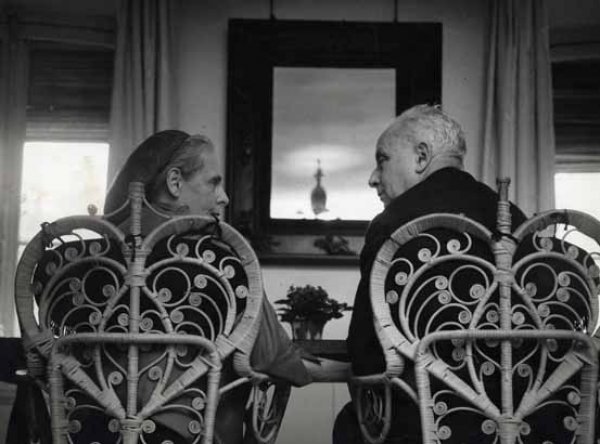He studied medicine and became a poet: Who is Louis Aragon?
He has an interesting "growth" story: his parents were separated; his mother hid the existence of his father and introduced herself as his older sister.

(1897-1983) French poet, and novelist. He is one of the founders of the surrealism movement and one of the leading representatives of French socialist literature. He was born on October 3, 1897, in Paris. His mother and father were separated; his mother hid the existence of his father and introduced herself as his older sister. The family moved to Neuilly in 1904, Aragon was a very successful student, entering Saint-Pierre High School in 1908.
He began his medical education in 1914. Three years later, enlisting in the final year of World War I, he met Andre Breton, a medical student like him. In 1918, he received a medal for his usefulness at the front. He met Paul Eluard and Philippe Soupault. After his discharge, he left his medical education, which he started again, in 1921, and started working as a librarian.
He settled in Giverny in 1923, beginning to break away from the Dadaist movement he had joined three years earlier. The following year, he joined the views in line with Breton's "Manifesto of Surrealism" and Revolution Surrealist magazine. However, after 1928, a great change began in his aesthetic and political views. He went to the USSR with the novelist Elsa Triolet, whom he married in the same year, and stayed there for a year. He participated in the Revolutionary Writers Congress held in Kharkiv in 1930. By 1932 he had completely broken with Breton and the Surrealism movement. He started working at l'Humanite, the publication organ of the French Communist Party (FKP). The following year he attended the First Congress of the Union of Soviet Writers.
He participated in the World Congress of Writers for the Defense of Culture held in Paris in 1935. The following year, he took over the management of Ce soir newspaper and became very close to Paul Nizan. When he returned from his trip to New York in 1939, he has enlisted again. Aragon, who participated in the French resistance movement organized against the Nazi occupation in Southern France, gained great fame with his poems that were secretly published and distributed.
After World War II, he returned to Paris and took over the management of various leftist magazines. In 1950, he was elected a member of the Central Committee of the CPI. He gave speeches at the demonstrations and meetings of the students in the May 1968 events. He entered Goncourt Academy in 1969 but left shortly thereafter. The death of his wife and political friend Elsa Triolet in 1970 shook Aragon. Aragon, who participated as the official French representative in the ceremonies celebrating the sixtieth anniversary of the October Revolution in 1977, has only been preparing new editions of his old works and participating in some conferences and TV speeches in recent years. He died in Paris in January 1983.
Aragon began his first writing experiments at a very young age. He developed his views on poetry together with Breton, whom he met at the front. He published his first poems in the journal Nord-Sud in 1918. These poems were under the influence of the Dadaism movement led by Tristan Tzara. The Dadaists, who stated that they were against the rules of poetry that had existed until that day, as well as against the rules of society, war, and traditions, made their objections pointless. When Aragon's first poetry book, Le fen de joie ("Fire of Kıvanç") was published in 1920 and his novel Anicet on le panorama (Anicet) was published a year later, it aroused great repercussions and received positive reviews from the master writers of the period. Aragon left Dadaism in 1924 and, together with Breton, began to pioneer the Surrealist movement in the Revolution Surrealist journal. Le paysan de Paris (“The Parisian Peasant”), published in 1925, is considered one of the masterpieces of this movement.
The year 1928 was a turning point in Aragon's life. The meeting of Mayakovsky and his lover Lili Brik with his sister, the novelist Elsa Triolet, started the formation of a love that would fill the poet's whole life and the worldview that would determine his next poetic adventure. Aragon had been interested in Marxist thought before; it was only after 1928 that this teaching began to guide his life. Having cut off his relationship with the Surrealists, the poet turned to traditional lyrical forms in his poetry. The poems of this period are grouped around three main themes: His poems praising socialism as a form of society; patriotic poems, especially from the days of war and resistance; love poems about the world, life, and nature, although it is embodied in his wife Elsa.
In a series of novels, he wrote under the title Le monde real ("The Real World"), he expressed the internal decay of the European bourgeoisie, the living conditions, and aspirations of the working class. In his novel La semaine sainte ("Holy Week"), considered the most successful of these, he presented France of the 1810s from a Marxist perspective. He re-evaluated the classical writers in his numerous articles and essays; He introduced Soviet literati to French readers.
Louis Aragon, with his versatile personality and strong pen, was both influenced by different artistic tendencies and influenced others during a long period in which Europe went through dramatic changes and successive generations were in different artistic and political pursuits.
